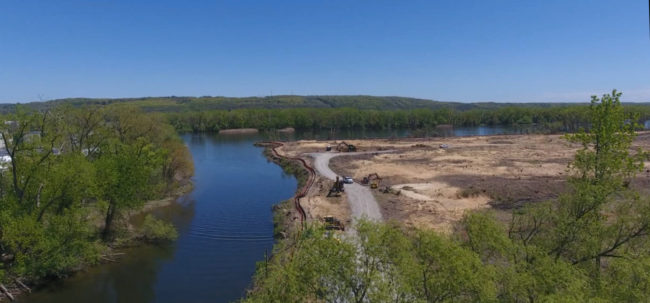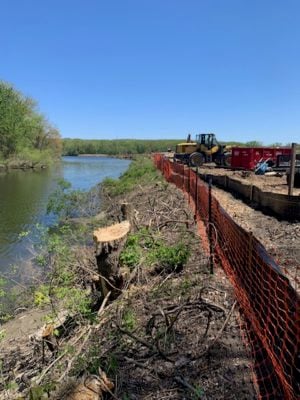EPA and NOAA identify problems with Port of Albany wind energy site

View more images on our Flickr site
Tree-clearing on Beacon Island, along the Hudson River and Normans Kill, is among the missteps at proposed turbine manufacturing site. Let’s pursue wind energy without collateral damage to the local environment.

As our society enters the necessary but challenging transition to clean energy to combat climate change, it is important to ensure that we do not cause collateral environmental damage along the way.
New York State has a laudable plan to develop 9,000 megawatts of offshore wind energy by 2035. Riverkeeper supports generating clean, renewable power through wind energy. New York is working quickly to build out its supply chain to create massive wind turbines and is improving existing industrial ports to achieve this goal. The Port of Albany has proposed Beacon Island as one of these sites for the manufacture of offshore wind turbines.

Beacon Island is an 82-acre parcel just south of the Port of Albany on the Hudson River’s west bank. It is immediately south of a tributary called Normans Kill. The Port of Albany bought the property three years ago for the purpose of developing the property to build components for offshore wind turbines.
A controversy arose in May, when 80 acres of wooded land on the site were suddenly clear cut under a New York State Department of Environmental Conservation permit – but before required federal approvals were obtained.
In June and July, the U.S. Environmental Protection Agency (EPA) and the National Oceanic and Atmospheric Administration (NOAA) called out several significant problems with this proposed project.
“It appears that potential impacts to anadromous and resident fish that use this section of the Hudson River as migratory, spawning, nursery, resting, and foraging habitat were not fully considered during project planning and design,” NOAA stated in comments to the U.S. Army Corps of Engineers.
Both the EPA and NOAA recommend that the Army Corps permit for the project not be granted until proper assessment and modifications are made:
• The EPA and NOAA state that alternatives, including other locations, must be considered in the proposal.
• The project proposes to permanently impact .81 acres of wetland without considering alternatives to avoid and minimize environmental impacts. The proposal does not provide justification for why these locations were chosen.
• Proposed in-water construction would fragment habitat, disrupting and damaging a .21-acre bed of important underwater grasses and the many fishes that use this section of the Hudson River as migratory, spawning, nursery, resting, and foraging habitat. Similar to the wetland impacts, there is no justification provided for why construction of a wharf in this location is needed. The EPA and NOAA call for studies of alternatives, and NOAA calls for fish impacts to be properly considered.
• As stated by the EPA and NOAA, the project’s plan to replace the affected habitat is inadequate, and the project cannot proceed until a proper plan is identified.
• The entire site is within the 100-year flood plain of the Hudson River, which leaves it prone to flooding, especially as climate change intensifies.
• The tree clearing went beyond the limits of the proposed permit. “EPA recommends full restoration of cleared forested wetland areas that are not authorized for impact under the proposed permit,” the agency wrote in its June 23 letter to the Corps.
Riverkeeper is a member of the NY Offshore Wind Alliance, and fully supports wind energy development and other alternatives to fossil fuels. Riverkeeper also supports the recommendations by EPA and NOAA concerning local environmental impacts of the proposed project. We call upon the New York DEC and the Town of Bethlehem Planning Board to follow the federal agencies in examining these issues closely, and consider alternative sites and designs to minimize impacts.
In addition, community members have raised concerns about the environmental impacts from the disturbance of 2 million tons of coal ash on the site, and the project’s infringement of the Town of Bethlehem’s zoning code. The coal ash is a waste product from a local coal-fired power plant. Coal ash contains contaminants such as arsenic, lead and mercury. The zoning code requires a 100-foot no-build buffer along the Normans Kill Creek, and prohibits development within the 100-year flood zone of the creek bank. Riverkeeper urges all regulatory entities to seriously consider the local community’s concerns, and uphold the local zoning code.
The coal ash that remains on the property is a concern. Actions must be taken to prevent contaminants from being mobilized into the Hudson River and local waterways as a result of any construction on the site, sea level rise and inevitable increased frequency of flooding at Beacon Island.
New York State has failed in its oversight of the Beacon Island site, and must do better. We cannot reach a sustainable future if we disregard our local environments and communities in the process.
More information:
Letter from EPA to the U.S. Army Corps of Engineers, June 23, 2022
Letter from NOAA to the U.S. Army Corps of Engineers, July 11, 2022
